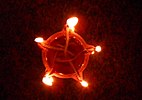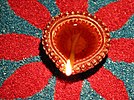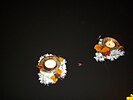Diya (light)
Diya, or oil lamp, in different formations | |||||||
A Diya, diyo, deya,[1] divaa, deepa, deepam, or deepak is an oil lamp. It is used in the Indian subcontinent, mostly in India and Nepal. It is usually made from clay and a cotton wick dipped in ghee or vegetable oils. Diyas are native to the Indian subcontinent. It is often used in Hindu, Sikh, Jain and Zoroastrian religious festivals such as Diwali[2] or the Kushti ceremony.
References[edit]
- ↑ Sacred Places of a Lifetime. Washington DC: National Geographic Society. 2008. p. 270. ISBN 978-1-4262-0336-7.
- ↑ "Diwali: Significance of a Diya". Zee Media Corporation Ltd. Retrieved July 19, 2013.






